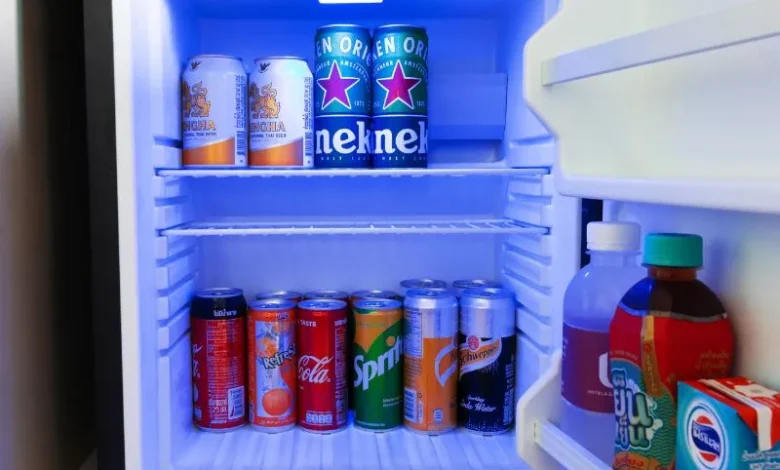Comprehensive Guide to Commercial Fridges

Introduction
Definition of Commercial Fridges
A commercial fridge, also known as a commercial refrigerator, is a refrigeration unit designed specifically for use in commercial environments such as restaurants, cafes, supermarkets, and other food service establishments. Unlike domestic refrigerators, commercial fridges are built to handle the higher demands of commercial operations, providing more robust cooling solutions and often incorporating features that support the specific needs of businesses.
Importance in Various Industries
Commercial fridges play a crucial role in maintaining the quality and safety of perishable goods. They are essential for:
- Restaurants and Cafes: Ensuring ingredients are stored at optimal temperatures to preserve freshness and prevent foodborne illnesses.
- Supermarkets and Grocery Stores: Keeping a wide range of products, from dairy to meat, fresh and safe for consumers.
- Hospitals and Medical Facilities: Storing medications, vaccines, and samples at precise temperatures to maintain their efficacy.
- Catering Services: Offering reliable storage solutions that support large-scale food preparation and service.
Types and Categories of Commercial Fridges
Upright Refrigerators
Upright refrigerators, also known as reach-in refrigerators, are vertical units that offer ample storage space with easy access to stored items. They are ideal for kitchens with limited floor space but require efficient vertical space utilization.
Undercounter Refrigerators
Undercounter refrigerators are compact units designed to fit under counters or workspaces. These fridges are perfect for kitchens that need extra refrigeration but have limited space. They are often used in bars, coffee shops, and small kitchens.
Walk-In Coolers
Walk-in coolers are large, room-sized refrigeration units that provide substantial storage space for bulk items. They are commonly used in restaurants, grocery stores, and food production facilities. These coolers can be custom-built to fit specific space requirements and are essential for operations that need to store large quantities of perishable goods.
Reach-In Refrigerators
Reach-in refrigerators are similar to upright refrigerators but are designed for easy access to stored items. They typically feature multiple shelves and sections, making it easier to organize and retrieve products. These fridges are popular in restaurant kitchens, where quick access to ingredients is crucial.
Display Refrigerators
Display refrigerators are designed to showcase products to customers while keeping them at the proper temperature. These units are commonly found in grocery stores, convenience stores, and bakeries. They often feature glass doors and interior lighting to enhance product visibility and attract customers.
Prep Table Refrigerators
Prep table refrigerators combine refrigeration and workspace in one unit. They are designed with a refrigerated base and a work surface on top, making them ideal for food preparation tasks. These fridges are commonly used in pizza shops, sandwich shops, and other food service operations that require a continuous supply of fresh ingredients at hand.
Bar Refrigerators
Bar refrigerators are specialized units designed for storing beverages. They come in various configurations, including bottle coolers, keg coolers, and wine refrigerators. These units are essential for bars, pubs, and restaurants that serve a wide range of drinks and need to keep them at optimal serving temperatures.
Blast Chillers
Blast chillers are powerful refrigeration units that rapidly lower the temperature of food items. They are used to quickly cool cooked foods to safe storage temperatures, preventing the growth of harmful bacteria. Blast chillers are vital in environments where food safety and quick service are priorities, such as catering services and high-volume restaurants.
Medical Refrigerators
Medical refrigerators are specialized units designed to store medical supplies, including medications, vaccines, and blood samples, at precise temperatures. These fridges must comply with stringent health standards to ensure the safety and efficacy of stored items. They are used in hospitals, clinics, and research laboratories.
Technical Specifications
Cooling Systems
Commercial fridges employ various cooling systems to maintain consistent temperatures:
- Compressor-Based Cooling: Most common system, using a compressor to circulate refrigerant and remove heat from the interior.
- Absorption Cooling: Uses a heat source to drive the cooling process, often used in portable units.
- Thermoelectric Cooling: Uses electric current to transfer heat, suitable for small, lightweight fridges.
Temperature Control
Accurate temperature control is crucial for maintaining food safety and quality:
- Thermostatic Controls: Allow precise temperature settings and adjustments.
- Digital Monitoring Systems: Provide real-time temperature readings and alerts for deviations, ensuring compliance with safety standards.
Energy Efficiency
Energy efficiency is a key consideration for commercial fridges, impacting both operational costs and environmental footprint:
- Energy Star Ratings: Look for fridges with high Energy Star ratings for better efficiency.
- Innovations in Energy-Saving Technology: Features like LED lighting, improved insulation, and energy-efficient compressors help reduce energy consumption.
Storage Capacity
Storage capacity is measured in cubic feet or liters, indicating the volume of space available for storing items:
- Volume Measurements: Ensure the fridge has adequate capacity for your needs without wasting space.
- Shelving Configurations: Adjustable shelves and compartments enhance storage flexibility and organization.
Material and Build Quality
The build quality of a commercial fridge affects its durability and ease of maintenance:
- Common Materials Used: Stainless steel is preferred for its durability, ease of cleaning, and resistance to corrosion.
- Durability and Maintenance: Regular maintenance, such as cleaning condenser coils and checking seals, prolongs the fridge’s lifespan and ensures optimal performance.
Applications in Various Industries
Food and Beverage Industry
Commercial fridges are indispensable in the food and beverage industry, ensuring that ingredients and products are stored safely and efficiently:
- Restaurants and Cafes: Maintain freshness and comply with food safety regulations.
- Supermarkets and Grocery Stores: Display and preserve a wide range of perishable goods, from produce to dairy products.
Healthcare Sector
In the healthcare sector, precise temperature control is critical for preserving the efficacy of medical supplies:
- Hospitals and Clinics: Store medications, vaccines, and blood samples at specific temperatures to ensure their effectiveness.
- Pharmaceutical Storage: Comply with regulations for the safe storage of sensitive drugs and biological materials.
Hospitality Industry
The hospitality industry relies on commercial fridges to provide high-quality service and maintain food safety standards:
- Hotels and Resorts: Store large quantities of food and beverages for guest services.
- Catering Services: Ensure prepared foods are kept at safe temperatures during transport and service.
Retail Sector
In the retail sector, commercial fridges are essential for preserving and displaying products attractively:
- Convenience Stores: Store and display beverages, snacks, and perishable items.
- Specialty Food Shops: Maintain the quality of high-end products like cheeses, meats, and chocolates.
Benefits of Commercial Fridges
Improved Food Safety
One of the primary benefits of commercial fridges is the enhancement of food safety:
- Temperature Regulation: Keeps food at safe temperatures to prevent spoilage and bacterial growth.
- Prevention of Bacterial Growth: Reduces the risk of foodborne illnesses by maintaining consistent, low temperatures.
Enhanced Efficiency
Commercial fridges help streamline kitchen operations, improving overall efficiency:
- Streamlined Kitchen Operations: Organized storage and quick access to ingredients enhance workflow and reduce preparation times.
- Reduced Food Waste: Proper storage conditions extend the shelf life of perishable goods, minimizing waste and loss.
Customer Satisfaction
Customer satisfaction is greatly influenced by the freshness and quality of products:
- Better Product Display: Display fridges showcase products attractively, encouraging purchases.
- Freshness and Quality Assurance: Consistent refrigeration ensures products are fresh and of high quality, meeting customer expectations.
Cost Savings
Investing in energy-efficient commercial fridges can lead to significant cost savings over time:
- Energy-Efficient Models: Lower energy consumption reduces utility bills.
- Reduced Spoilage and Waste: Minimizing food waste translates to cost savings for businesses.
Challenges and Limitations
High Initial Cost
One of the main challenges of commercial fridges is the high initial investment required:
- Purchase and Installation Expenses: High-quality commercial fridges can be expensive, and installation may require additional costs.
Maintenance Requirements
Regular maintenance is essential to ensure the longevity and performance of commercial fridges:
- Regular Servicing and Repairs: Periodic maintenance checks are necessary to keep the fridge running efficiently and prevent breakdowns.
Energy Consumption
Despite advancements in energy efficiency, commercial fridges can still consume significant amounts of energy:
- Operating Costs: High energy consumption can lead to increased utility bills, impacting the overall operating costs of a business.
Space Constraints
The size and placement of commercial fridges can pose challenges, especially in smaller kitchens:
- Size and Placement Issues: Ensuring adequate space for installation and operation without disrupting workflow can be difficult.
Compliance with Regulations
Meeting health and safety standards is crucial for businesses using commercial fridges:
- Meeting Health and Safety Standards: Compliance with local regulations and industry standards is essential to avoid penalties and ensure customer safety.
Latest Innovations in Commercial Fridges
Smart Refrigeration Technology
Advancements in technology have led to the development of smart refrigeration systems:
- IoT-Enabled Devices: Internet of Things (IoT) technology allows remote monitoring and control of fridges, enhancing efficiency and convenience.
- Remote Monitoring and Control: Businesses can monitor temperatures and receive alerts about potential issues in real-time, preventing spoilage and ensuring compliance with safety standards.
Eco-Friendly Refrigerants
The shift towards eco-friendly refrigerants is a significant trend in the refrigeration industry:
- Transition to Greener Alternatives: Using refrigerants with lower global warming potential (GWP) reduces environmental impact.
- Impact on Environmental Sustainability: Eco-friendly refrigerants help businesses reduce their carbon footprint and comply with environmental regulations.
Advanced Insulation Materials
Innovations in insulation materials have led to improvements in energy efficiency and temperature retention:
- Improvements in Energy Efficiency: Better insulation reduces energy consumption by maintaining consistent temperatures more effectively.
- Enhanced Temperature Retention: Advanced materials help keep the interior temperature stable, even during frequent door openings.
Innovative Cooling Mechanisms
New cooling mechanisms are being developed to improve the efficiency and performance of commercial fridges:
- Magnetic Refrigeration: Uses magnetic fields to cool, offering a more energy-efficient alternative to traditional compressor-based systems.
- Variable Speed Compressors: Adjust compressor speed based on cooling demand, reducing energy consumption and improving temperature control.
Future Prospects
Technological Advancements
The future of commercial fridges looks promising, with continuous technological advancements:
- Predictions for the Next Decade: Innovations such as AI-driven systems, enhanced IoT integration, and improved energy efficiency are expected.
- Integration with Other Smart Kitchen Devices: Seamless integration with other smart appliances will streamline kitchen operations and enhance efficiency.
Market Trends
Several market trends are shaping the future of commercial fridges:
- Growing Demand for Energy-Efficient Models: Businesses are increasingly prioritizing energy efficiency to reduce costs and environmental impact.
- Sustainability Initiatives: The industry is moving towards more sustainable practices, including the use of eco-friendly refrigerants and energy-efficient designs.
Regulatory Changes
Anticipated regulatory changes will impact the commercial refrigeration industry:
- Updates in Health and Safety Standards: Stricter regulations will require businesses to adopt advanced technologies to ensure compliance.
- Environmental Regulations: New laws aimed at reducing environmental impact will drive the adoption of greener refrigeration solutions.
Comparative Analysis
Commercial vs. Domestic Fridges
Understanding the differences between commercial and domestic fridges can help businesses make informed decisions:
- Key Differences in Design and Function: Commercial fridges are built for durability and high performance, while domestic fridges focus on convenience and aesthetics.
- Pros and Cons of Each: Commercial fridges offer greater capacity and robustness but at a higher cost; domestic fridges are more affordable but less suited for high-demand environments.
Comparison Among Commercial Fridge Types
Comparing different types of commercial fridges helps identify the best option for specific needs:
- Specific Use Cases: Each type of fridge is designed for particular applications, such as display fridges for retail or blast chillers for food preparation.
- Performance Metrics: Factors like cooling speed, energy efficiency, and storage capacity vary among fridge types and should be considered when making a selection.
User Guides and Tutorials
Installation Guide
Proper installation is crucial for the optimal performance of commercial fridges:
- Step-by-Step Setup Instructions: Follow manufacturer guidelines to ensure correct installation and avoid common mistakes.
- Common Installation Mistakes to Avoid: Ensure proper ventilation, avoid placing the fridge near heat sources, and level the unit to prevent operational issues.
Maintenance Tips
Regular maintenance helps extend the lifespan of commercial fridges and ensures efficient operation:
- Routine Cleaning and Servicing: Clean condenser coils, check door seals, and defrost regularly to maintain efficiency.
- Troubleshooting Common Issues: Identify and address issues like temperature fluctuations, unusual noises, and condensation buildup promptly.
Energy-Saving Practices
Implementing energy-saving practices can reduce operating costs and enhance efficiency:
- Optimizing Fridge Usage: Keep the fridge well-stocked to maintain temperature, avoid frequent door openings, and organize contents for better airflow.
- Regular Checks for Energy Efficiency: Monitor energy consumption, check for leaks, and ensure the fridge is operating within optimal parameters.
Conclusion
Summary of Key Points
Choosing the right commercial fridge is essential for maintaining food safety, enhancing operational efficiency, and ensuring customer satisfaction. By understanding the different types of fridges, their technical specifications, and their applications in various industries, businesses can make informed decisions that meet their specific needs.
Final Recommendations
When selecting a commercial fridge, consider factors such as energy efficiency, storage capacity, and specific industry requirements. Stay informed about the latest innovations and regulatory changes to ensure your refrigeration solutions are up-to-date and compliant with industry standards.



